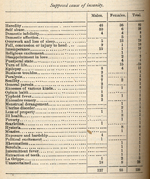In
1890 the state hospital at Brattleboro was feeling the pressure of a rise
in insanity in Vermont. The hospital could comfortably hold 400 patients,
but for at least 10 years it had been above capacity. To make room for
new patients, the hospital released 109 of the chronically insane, but
harmless residents. The trustees were unhappy with the decision to release
these patients because they were the patients who were considered fit
for “dorm life,” meaning that they were quiet and easily controlled.
They were also patients of the state, which allowed the hospital to collect
revenues just by keeping them there. The patients that Brattleboro maintained
after dismissing these 109 were transient or criminally insane, and no
private revenue or state funding was received for them.
The trustee’s anger at releasing patients led to the decision to build a new state hospital in Waterbury. In 1889 the decision was made to erect the Vermont State Hospital for the Insane at Waterbury; this hospital would house the criminally insane and the insane poor, in turn opening Brattleboro up for private and state-funded patients. In the supervisors report for 1889, there was a recommendation that the poor insane of Vermont (state-funded patients) should take the place of the 21 convicts and 104 transient insane currently being kept at Brattleboro; this led to the assumption that money was the driving force behind the push for a new state hospital at Waterbury.
The trustee’s anger at releasing patients led to the decision to build a new state hospital in Waterbury. In 1889 the decision was made to erect the Vermont State Hospital for the Insane at Waterbury; this hospital would house the criminally insane and the insane poor, in turn opening Brattleboro up for private and state-funded patients. In the supervisors report for 1889, there was a recommendation that the poor insane of Vermont (state-funded patients) should take the place of the 21 convicts and 104 transient insane currently being kept at Brattleboro; this led to the assumption that money was the driving force behind the push for a new state hospital at Waterbury.
Typical treatment for insanity in Vermont around 1890 was a steady dose of activity; the superintendent wrote that the worst thing one could do for an insane person was to confine him or her with nothing to do. The State Hospital at Brattleboro had a farm, a park, a summer cottage, a gymnasium and gardens, each of which was used to divert the patients’ attentions away from their afflictions. In an effort to improve treatment for the insane, instructional courses for Brattleboro employees were initiated in 1890.
